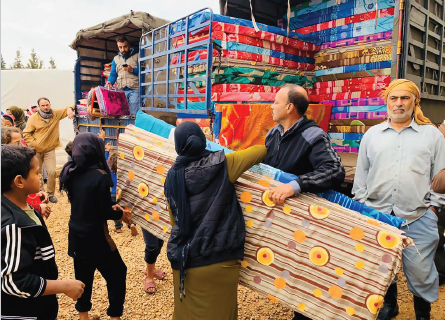It is still not safe for refugees to return to Syria. Just ask those who have done so.
That’s what researchers did for a report published today about the millions of Syrian refugees stuck in limbo in the countries neighbouring Syria. Their situation is deteriorating, but going back is also not a good option.
In one of the only studies documenting the situation for refugee returnees to Syria, the Refugee Protection Watch coalition (RPW) has conducted surveys of hundreds of refugees in Lebanon, and conducted face-to-face interviews with scores of refugees who have returned to Syria. In addition, RPW has reviewed dozens of other studies involving Syrian refugees. The result is a thorough and disturbing overview of the dire plight of the approximately 5.5 million Syrian refugees in neighbouring countries. RPW recommends EU member states, the EU itself, and governments in the region, take urgent action.
“This research project is one of the only initiatives which has been able to systematically document the situation for some of the small number of refugees who have – despite the dangers – returned to Syria,” says PAX Middle East Project Leader Pim Gerritsen.
Not safe to return
The UN has stipulated 22 conditions that have to be met before refugees can return safely to Syria. Reviewing those conditions one by one shows that Syria is a long way from being safe for refugees to return. A small sampling: returnees do not feel safe and secure in general, and many, particularly military-aged men, fear being arbitrarily detained; unemployment, poverty and hunger are widespread; over three quarters of returnees are dependent on aid; electricity, water and access to medical care are intermittent and unpredictable.
A man interviewed for the report who returned to Eastern Ghouta says, “I don’t feel safe in the presence of the military and the security forces everywhere in our town.”
Another threshold for safe return listed by the UN is that refugees can make an informed and voluntary decision to return. At the moment, this is usually not possible. Conditions in host countries are deteriorating, while at the same time it is difficult for refugees to get objective and reliable information about the conditions in Syria. The UNHCR currently does not have a system in place to monitor whether current returns can be considered safe, voluntary and dignified.
The COVID-19 pandemic has further compounded hardships of Syrian refugees in Lebanon.
Need for durable solutions
The RPW study concludes that Syrian refugees see no likelihood for a durable solution to end their displacement in the near future. They are stuck in limbo while conditions around them are worsening. Conditions in Syria are not conducive for a safe and dignified return, while the rapidly deteriorating situation in Lebanon makes a voluntary and informed return decision impossible.
The international community, as well as local authorities, need to take urgent action to tackle the rapidly deteriorating situation of Syria’s displaced. In doing so, refugee-hosting countries, international institutions, and donors need to ensure and apply a holistic approach that recognizes that the 3 internationally-recognized durable solutions for displaced Syrians are inherently interlinked and should be actively and simultaneously promoted.
Refugee Protection Watch coalition
The Refugee Protection Watch (RPW) is a coalition formed in 2019 by ALEF – Act for Human Rights, Basmeh and Zeitooneh, PAX, Upinion and 11.11.11. It brings together the strengths and experiences of Lebanese, Syrian and European organisations working in the human rights, peacebuilding, development and humanitarian fields, as well as a social profit enterprise (Upinion) specialised in digital data collection among (refugee) communities.
This report is the first in a series of other monitoring reports that will be published twice a year in the period of 2020-2021.
Trapped in between Lebanon and Syria




